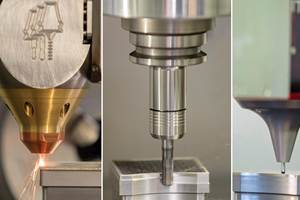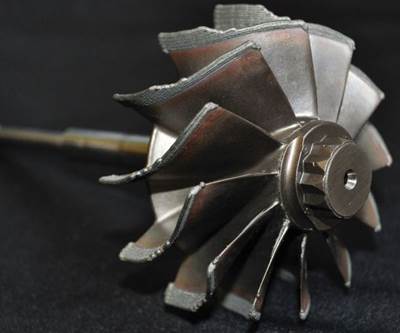AM 101: What is Ultrasonic Additive Manufacturing?
Going from additive to subtractive can be simple with Ultrasonic Additive Manufacturing (UAM). What is it and how does it work? Learn the basics in this 101 post.
Share
How Does Ultrasonic Additive Manufacturing Work?
This process, with minimal heating, results in a solid-state atomic bond or weld between the thin metal tape and the substrate. Multiple layers are welded together one after the other to build up height. Photo Credit: Fabrisonic
Ultrasonic additive manufacturing works by layering thin metal sheets or tape which are then vibrated together until they fuse.
In UAM, material is not melted, but instead joined through ultrasonic welding. This welding uses high-frequency vibration to join surfaces while the metal remains solid. By welding layer upon layer upon layer in this way, the process builds solid, dense metal parts.
While under high-frequency ultrasonic vibration and constant pressure, the ultrasonic motion breaks up oxides through friction, enabling the direct contact of metal on metal.
And as Mark Norfolk of Fabrisonic said in the first episode of The Cool Parts Show, “As soon as you have virgin metal touching virgin metal, mother nature takes over and you get a solid-state bond.”
This solid-state bond can be formed even between dissimilar metals, allowing for the creation of multimaterial parts that combine materials, like copper for cooling inside an aluminum part. The process repeats until a solid part has been built.

The Fabrisonic ultrasonic additive manufacturing machine has a work envelope of 6 × 6 × 3 feet. Developed by Fabrisonic, the machine is built by Ultra Tech Machinery, another Ohio Company.
Can Ultrasonic Additive Manufacturing Be Combined with Other Processes?
UAM can be combined with CNC machining in a hybrid format to enable cutting features and finish machining during the manufacturing process. Hybrid machines are available for this process that offer CNC contour milling to obtain required tolerances and optimal surface finish.
Ultrasonic additive manufacturing can also be used in conjunction with other additive manufacturing processes, such as augmenting an intricate part made via laser powder bed fusion with layers of similar or dissimilar materials.
What Materials Can Be Used with UAM?
Ultrasonic additive manufacturing is compatible with a wide range of metals, including alloys of aluminum, copper, magnesium, nickel and titanium.
Why Use Ultrasonic Additive Manufacturing?
The solid-state process makes it easy to embed sensors or other objects into solid parts. The build is simply paused as the embedded object is added, then the build continues to seal it inside.
The bonding temperature for all metals is below the melting temperature, which avoids problems with thermal deformation.
UAM also provides a reliable way to join dissimilar metals without creating brittle metallurgy. A hard metal outer surface could be built onto a structure made from a lighter metal to provide a part with both durability and light weight. Or, two very different metals — titanium and aluminum, say — could be combined in shuffled layers to create a structure that mixes the properties of both.
This technology combines the usefulness of additive and subtractive manufacturing, allowing parts with complex geometries and internal passageways to be built. The fine dimensional accuracy and smooth surfaces of the parts built with UAM and machining prove the possibilities of hybrid manufacturing.
Related Content
Machine Tool Drawbar Made With Additive Manufacturing Saves DMG MORI 90% Lead Time and 67% CO2 Emission
A new production process for the multimetal drawbar replaces an outsourced plating step with directed energy deposition, performing this DED along with roughing, finishing and grinding on a single machine.
Read MoreHybrid Additive Manufacturing Improves Debarking Knife Tip Strength and Production Efficiency
Nicholson Manufacturing chose the Mastercam APlus specialized add-on to unlock hybrid manufacturing for making its debarker knife tips, enabling it to add durable layers to the wear surfaces of the tips to make them more resilient while also making the production process more efficient.
Read MoreVideo: For 3D Printed Aircraft Structure, Machining Aids Fatigue Strength
Machining is a valuable complement to directed energy deposition, says Big Metal Additive. Topology-optimized aircraft parts illustrate the improvement in part performance from machining as the part is being built.
Read More5 Points You Might Not Know About Hybrid CNC Machine Tools
Hybrid Manufacturing Technologies’ co-founder describes the role of hybrid additive manufacturing machines, and explores their possibilities related to heat treating, multimaterial tooling and making parts with embedding sensing.
Read MoreRead Next
This Rocket Fuel Injector Is a Solid Part That Contains a Working Motor: The Cool Parts Show #1
Our new video series debuts with a look at a solid metal part made through additive manufacturing that was built with a motor embedded inside. The motor sealed within the part adjusts the rocket’s fuel mixture while the rocket is in flight.
Read MoreHigh-Frequency Production
The additive process that grew out of ultrasonic welding provides an efficient way to produce complex work, including parts with embedded components and even parts made from dissimilar metals.
Read MoreAM 101: Hybrid Manufacturing
Additive manufacturing offers powerful capabilities alone, but even more opportunities are opened when AM is combined with subtractive processes.
Read More







